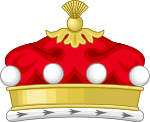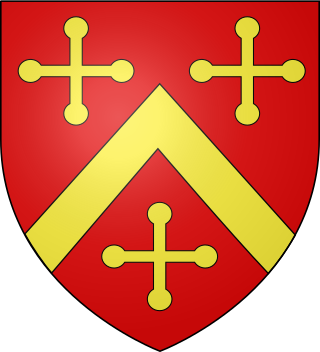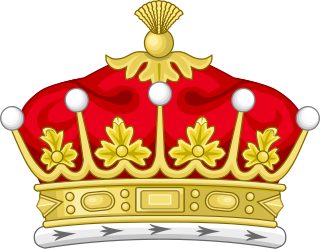Barons Broughshane (1945)
- William Henry Davison, 1st Baron Broughshane (1872–1953)
- Patrick Owen Alexander Davison, 2nd Baron Broughshane (1903–1995)
- (William) Kensington Davison, 3rd Baron Broughshane (1914–2006)
  |
|
Baron Broughshane, of Kensington in the County of London, was a title in the Peerage of the United Kingdom. [1] It was created on 19 September 1945 for William Davison, who had earlier represented Kensington South in the House of Commons as a Conservative. The title became extinct on the death of his younger son, the third Baron (who had succeeded his elder brother in 1995), on 24 March 2006.
  |
|

Earl of Holland was a title in the Peerage of England. It was created in 1624 for Henry Rich, 1st Baron Kensington. He was the younger son of Robert Rich, 1st Earl of Warwick, and had already been created Baron Kensington in 1623, also in the Peerage of England, having married Isabelle Cope, daughter and sole heiress of Sir Walter Cope (c.1553-1614), of Cope Castle in Kensington, Middlesex. His eldest son, the second Earl, succeeded his first cousin as fifth Earl of Warwick in 1673. All the titles became extinct on the death of the eighth Earl of Warwick and fifth Earl of Holland in 1759.

Earl of Ilchester is a title in the Peerage of Great Britain. It was created in 1756 for Stephen Fox, 1st Baron Ilchester, who had previously represented Shaftesbury in Parliament. He had already been created Baron Ilchester, of Ilchester in the County of Somerset in 1741, and Baron Ilchester and Stavordale, of Redlynch, in the County of Somerset, in 1747. These titles were also in the Peerage of Great Britain. All three peerages were created with remainder, failing heirs male of his own, to his younger brother Henry Fox, who was himself created Baron Holland in 1763. The brothers were the only sons from the second marriage of the politician Sir Stephen Fox.
Viscount Mills, of Kensington in the County of London, is a title in the Peerage of the United Kingdom. It was created on 22 August 1962 for the Conservative politician Percy Mills, 1st Baron Mills. He had already been created a Baronet, of Alcester in the County of Warwick, in the Baronetage of the United Kingdom on 1 July 1953, and as Baron Mills, of Studley in the County of Warwick, on 22 January 1957, also in the Peerage of the United Kingdom. As of 2017 the titles are held by his grandson, the third Viscount, who succeeded his father in 1988.
Viscount Camrose, of Hackwood Park in the County of Hampshire, is a title in the Peerage of the United Kingdom. It was created on 20 January 1941 for the prominent newspaper magnate William Berry, 1st Baron Camrose. He had previously received the award of Baronet, of Long Cross in the County of Surrey, in the Baronetage of the United Kingdom, on 4 July 1921, and was created Baron Camrose, of Long Cross in the County of Surrey, on 19 June 1929, in the Peerage of the United Kingdom. His second son, the third Viscount, disclaimed the peerages in 1995 on succeeding his elder brother. However, he had already been created a life peer as Baron Hartwell, of Peterborough Court in the City of London, on 19 January 1968. On his death in 2001 the life peerage became extinct while he was succeeded in the other titles by his eldest son, the fourth Viscount. The first three Viscounts all headed The Daily Telegraph at one point, the first having purchased it from Harry Levy-Lawson, 1st Viscount Burnham, but in the 1980s they lost control to Conrad Black.

Viscount De L'Isle, of Penshurst in the County of Kent, is a title in the Peerage of the United Kingdom. It was created in 1956 for William Sidney, 6th Baron de L'Isle and Dudley, VC, KG, GCMG, GCVO (1909–1991).
Baron Kensington is a title that has been created three times, in the Peerages of England, Ireland and the United Kingdom.

Baron Howard of Penrith, of Gowbarrow in the County of Cumberland, is a title in the Peerage of the United Kingdom. It was created in 1930 for the diplomat Sir Esme Howard, who had previously served as British Ambassador to the United States. A member of the famous Howard family, he was the grandson of Lord Henry Howard-Molyneux-Howard, younger brother of Bernard Howard, 12th Duke of Norfolk. As of 2010 the title is held by his grandson, the third Baron, who succeeded his father in 1999. Lord Howard of Penrith is also in remainder to the dukedom of Norfolk and its subsidiary titles.
Baron Altrincham, of Tormarton in the County of Gloucester, is a title in the Peerage of the United Kingdom. It was created on 1 August 1945 for the politician Edward Grigg. His son, the second Baron, was a politician, journalist, historian and writer. Soon after the passage of the Peerage Act 1963 on 31 July 1963, he disclaimed the title for life. As of 2020 the title is held by his nephew, who succeeded as 4th Baron on his father's death in that year.

Baron Kilbracken, of Killegar in the County of Leitrim, is a title in the Peerage of the United Kingdom. It was created in 1909 for the senior civil servant Sir Arthur Godley. He was Permanent Under-Secretary of State for India between 1883 and 1909. As of 2010 the title is held by his great-grandson, the fourth Baron, who succeeded his father in 2006.
Baron Keyes, of Zeebrugge, and Dover in the County of Kent, is a title in the Peerage of the United Kingdom. It was created in 1943 for the prominent naval commander Admiral of the Fleet Sir Roger Keyes, 1st Baronet. He is chiefly remembered for his role in the Zeebrugge Raid in 1918, an attempt by the Royal Navy to neutralize the Belgian port of Zeebrugge which was used as a base for German submarine attacks on Allied shipping. Keyes had already been created a Baronet, of Zeebrugge, and of Dover in the County of Kent, in the Baronetage of the United Kingdom in 1919. As of 2010 the titles are held by his grandson, the third Baron, who succeeded his father in 2005. He does not use his title.
Baron Westwood, of Gosforth in the County of Northumberland, is a title in the Peerage of the United Kingdom. It was created in 1944 for the trade unionist William Westwood. He was General Secretary of the Ship Constructors' and Shipwrights' Association from 1929 to 1945. As of 2019 the title is held by his great-grandson, the fourth Baron, who succeeded his father in that year.

Baron Strathcarron, of Banchor in the County of Inverness, is a title in the Peerage of the United Kingdom. It was created on 11 January 1936 for the Liberal politician Sir Ian Macpherson, 1st Baronet. He had already been created a baronet, of Drumalban on 26 April 1933. As of 2017, the titles are held by his grandson, the third Baron, who succeeded his father in 2006.

Baron St Helens is a title that has been created three times, once in the Peerage of Ireland and twice in the Peerage of the United Kingdom.

Baron Phillimore, of Shiplake in the County of Oxford, is a title in the Peerage of the United Kingdom. It was created in 1918 for the former Judge of the High Court of Justice and Lord Justice of Appeal, Sir Walter Phillimore, 2nd Baronet. The Phillimore Baronetcy, of The Coppice, had been created in the Baronetage of the United Kingdom on 28 December 1881 for his father Sir Robert Phillimore, who was also a noted lawyer and judge. The first Baron was succeeded by his son, the second Baron.

Baron Piercy, of Burford in the County of Oxford, is a title in the Peerage of the United Kingdom. It was created on 14 November 1945 for the economist, financier and civil servant William Piercy. As of 2010 the title is held by his grandson, the third Baron, who succeeded his father in 1981.

Baron Burnham, of Hall Barn in the Parish of Beaconsfield in the County of Buckingham, is a title in the Peerage of the United Kingdom. It was created on 31 July 1903 for the influential newspaper magnate Sir Edward Levy-Lawson, 1st Baronet, owner of The Daily Telegraph. He had already been created a Baronet, of Hall Barn in The Parish of Beaconsfield in the County of Buckingham and of Peterborough Court in the City of London, in the Baronetage of the United Kingdom on 13 October 1892. Levy-Lawson was the son of Joseph Moses Levy, who acquired The Daily Telegraph only months after its founding.
Baron Rennell, of Rodd in the County of Hereford, is a title in the Peerage of the United Kingdom. It was created in 1933 for the diplomat Sir Rennell Rodd, previously British Ambassador to Italy. His second but eldest surviving son, the second baron, served as president of the Royal Geographical Society from 1945 to 1948. He had no male issue and was succeeded by his nephew, the third baron. He was the only surviving son of Commander the Hon. Gustaf Guthrie Rennell Rodd, youngest son of the first baron. The third baron was a Scottish international rugby player. As of 2017 the title is held by his son, the fourth baron, who succeeded in 2006.

Baron Rea, of Eskdale in the County of Cumberland, is a title in the Peerage of the United Kingdom. It was created in 1937 for the businessman and Liberal politician Sir Walter Rea, 1st Baronet, who had earlier represented Scarborough, Bradford North and Dewsbury in the House of Commons. He had already been created a Baronet, of Eskdale in the County of Cumberland, in 1935. He was succeeded by his eldest son, the second Baron. During the Second World War he served as personal staff officer to Brigadier Colin Gubbins, the Head of SOE, a key British intelligence and guerrilla operations agency. Lord Rea served as Leader of the Liberal Party in the House of Lords from 1955 to 1967. His daughter, the Right Hon. Ann Felicity Rea, married SOE veteran Malcolm Munthe in 1945. His nephew, the third Baron, who succeeded in 1981, was a physician. He was one of the ninety elected hereditary peers elected to remain in the House of Lords after the passing of the House of Lords Act 1999, and sat on the Labour benches. As of 2020 the titles are held by his son, the fourth Baron, who succeeded his father in that year.

William Henry Davison, 1st Baron Broughshane, KBE, FSA, JP, DL was a British peer and Conservative Member of Parliament (MP) for Kensington South for twenty-four years.

William Edwardes, 2nd Baron Kensington, styled The Honourable William Edwardes until 1801, was a British peer and Member of Parliament. He was the instigator of the infamous Kensington Canal.